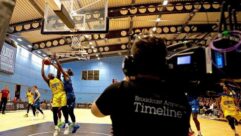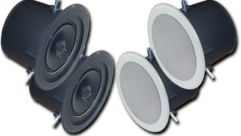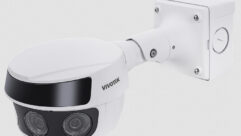Full Coverage
Aug 1, 2000 12:00 PM,
Dean Rivera
Proper surround loudspeaker selection and placement is essential tocapturing the level of audio realism that the end user expects from a hometheater system.
The popularity of home theater loud speakers systems is building aninterest in several types of surround loudspeakers. Manufacturers are nowmarketing surround loudspeakers that fall into the monopole, dipole andbipolar acoustic radiation pattern categories. Some manufacturers areproviding switches on their surround loudspeakers so that the user mayselect which type of radiation pattern they desire. With so many types ofsurround loudspeakers available, which pattern is best? Most articles onthis subject seem to favor placing the surround loudspeaker in a positionwhere a diffuse or non-directional pattern will be achieved. All seem toagree that proper placement is a key ingredient to achieving the bestsurround sound. This article will describe the characteristics of thevarious types of surround loudspeakers and offer suggestions as to theirplacement to achieve the best surround sound.
Large or small
For a while in audio technology, when Dolby Pro Logic was popular, thesurround loudspeaker needed to be able only to reproduce the audiobandwidth between 100 Hz and 8 kHz. Today, Dolby Digital and DTS arewidening the bandwidth requirements, suggesting that the surroundloudspeakers be the same as the main loudspeakers for the best effect.Practicality in terms of the size of the surround loudspeaker, however,plays an important role in room dAcor, so a small/large setting is nowbeing included in most surround processors. This feature allows the use ofsmaller, lower power handling surround loudspeakers to be used with thelarger front-channel loudspeakers. When the surround processor is set tothe “small” loudspeaker setting, the low-frequency information that wouldnormally go to the surround loudspeaker is rerouted to the mainloudspeakers or to a subwoofer.
In a two-way surround system, the woofer can see as much as 80% of thepower to the system, depending upon the crossover frequency. Setting thereceiver to the “small” setting protects the smaller surround loudspeaker’swoofer from being overdriven and damaged. Low-frequency information ingeneral is omnidirectional, making it difficult to locate the source. Thus,even small surround loudspeakers will seem to sound like large, full-rangeunits when the surround loudspeaker setting is set to “small”. Usingsurround loudspeakers that are the same size as the front threeloudspeakers is ideal but not always practical. When it is practical, thereis the “large” surround loudspeaker setting to allow all the information togo to the surround loudspeaker, giving the best surround effect. Let’s faceit; not even some of the best movie theaters have all the surroundloudspeakers the same size as the front-channel loudspeakers.
Timbre matching
Using all of the same loudspeakers in a home theater system is the optimumsetup in order to achieve the best timbre matching, which is a term used toindicate that each loudspeaker in a home theater system has the same soundcharacteristics and, therefore, sound equivalent. The advantage of atimbre-matched home theater system is that you get a sense of audiorealism, almost like actually being there. The loudspeakers seem todisappear into sort of an audio transparency. When this happens the user’sattention is drawn to the presentation itself. One of my favorite effectsis when horizontal audio pans invoke a seamless transition from loudspeakerto loudspeaker.
It is possible to have timbre matching with different types of loudspeakersas long as the midrange and tweeter tonal characteristics are similar. Itis much more difficult, however, to have timbre matching at low frequencieswhen using the same loudspeakers because of room loading and reflectioneffects. Using the test tone supplied with most home-theater receivers is aconvenient way to check for timbre matching among loudspeakers. If thefront main and center channel loudspeakers in your system sound similar atmid and high frequencies, consider the system timbre matched. Ifdifferences are noticeable, and you are using loudspeakers with the sametype of drivers in them, try matching the volume levels between theloudspeakers or repositioning them to aim toward the listening position. Ifyou still have dramatic sound character differences among the loudspeakers,then some room acoustic treatments may be needed in order to eliminate somemid- and high-frequency reflections.
Monopole, bipolar and dipole
Monopole surround loudspeakers are the basic configuration that has all thedrivers mounted on a single baffle. Side-firing woofer loudspeakers fallinto this category as well. Small bookshelf loudspeakers, satelliteloudspeakers or even the main front loudspeakers make an acceptablemonopole surround loudspeaker. The radiation pattern of a typical dometweeter two-way monopole surround loudspeaker (see Figure 1) is wide at lowfrequencies and gradually narrows at higher frequencies. A mono poleloudspeaker that uses a horn for the tweeter would have a similar radiationpattern at low frequencies, but the pattern at high frequencies would becontrolled, consistent with the coverage pattern of the horn (see Figure2). Monopole surround loudspeakers are usually mounted on the back wall oron the side walls about 2 feet to 3 feet (610 mm to 914 mm) above ear level.
Bipolar surround loudspeakers are two monopole loudspeakers in oneenclosure. The two loudspeakers are similar in construction to the dipoleloudspeakers, but instead of being wired out of phase, they are wired inphase. The acoustic energy, therefore, adds together, increasing the overall sensitivity of the loudspeaker. This arrangement helps to spread out the acoustic radiation pattern so that it is nearly omnidirectional throughoutits entire operating range (see Figure 3). The bipolar surroundloudspeaker, using a dome tweeter, has good high-frequency distribution.Bipolar surround loudspeakers are usually mounted on the back wall, theceiling or on the side walls about 2 feet to 3 feet (610 mm to 914 mm)above ear level.
Dipolar surround loudspeakers, like bipolar units, are two monopoleloudspeakers in one enclosure. To enhance bass performance the woofersections will sometimes have separate enclosures. Dipoles work by wiringtwo loudspeakers out of phase to create a null zone in the acousticradiation pattern, which is the region in the radiation pattern that emitsthe least sound output (see Figure 4). The radiation pattern of a properlydesigned dipole unit resembles a figure eight at all frequencies. Dipolesurround loudspeakers accomplish this by using the destructive interferenceeffects caused by wiring two monopoles out of phase.
Many factors come into play in designing a dipole loudspeaker to maximizethe null zone. The off-axis responses of each driver, their location andthe type of crossover slopes that will be used must all be weighed into thedesign by the loudspeaker engineer. It is then a matter of adjusting thecrossover to achieve the frequency response that will give the desiredcancellation or destructive interference effects. Angling the baffle on theopposite ends of a cabinet is a means for the engineer to widen or narrowthe effects of the null zone.
Tomlinson Holman pioneered the concept of using dipolar surroundloudspeakers for THX home theater systems, and dipolar surroundloudspeakers are an important part of that application. The dipolarloudspeakers used in THX home theater systems are classified asTHX-approved and have a flat power response when measured in a reverberantroom. This means that when the energy around the loudspeaker is averagedtogether, the result is a flat frequency-response curve. This loudspeakeris not easy to design because of the null zone effect. Once the design iscomplete and the loudspeakers are set up, however, the result is one of thebest surrounds for recreating a sense of envelopment and ambiance. Dipoleloudspeakers are usually set up on opposite walls so that the null zone isaimed toward the listener position with the loudspeakers mounted on thewall approximately 2 feet to 3 feet (610 mm to 914 mm) above ear level.
I have had the good fortune to design and work on two THX-approvedloudspeaker system projects. When I found out that the surrounds had tohave a flat power response curve to pass the THX requirements, Iimmediately thought of using horns to produce the high frequencies in thesurround loudspeakers. This was a good fit for the system because the left,center and right loudspeakers used horns as well, so timbre matching thesystem would be easier than if dome tweeters had been used. Horns wouldalso recreate the dynamics and performance of the majority of today’s movietheaters because they also use horns for the front-channel loudspeakers.
Using a horn-loaded tweeter instead of a dome tweeter also had theadvantage of controlling the directivity of the high-frequency energy. Thisbenefit increased the null zone several degrees over dipole loudspeakersthat use a dome tweeter. The null zone at high frequencies was also moreconsistent and was influenced less by the side wall and room reflectionsthanks to the directivity control of the horn. A main requirement of theTHX dipole surround loudspeaker is to ensure a diffuse radiation patternwhile maintaining a smooth frequency response. Not all units can make thisclaim.
Dome and horn tweeters
High-frequency devices commonly come in the form of a dome or horn. Eachhas its own dispersion and sound quality characteristics. Horns are knownfor their high sensitivity and pattern control. They usually cost more thanthe dome tweeters, but horns, because of their unique air-couplingcapabilities, can also have low distortion levels when compared todirect-radiator dome tweeters (see Figure 5).
Dome tweeters have a wide dispersion pattern throughout most of theiroperation range. Their radiation pattern then begins to narrow sharply asthe wavelength of the frequency it produces approaches the piston diameter(the moving area of the diaphragm) of its diaphragm. When the wavelengthproduced by the tweeter is equal to or less than its diaphragmcross-sectional piston area dimension, the dome tweeter begins to controldirectivity (see Figure 6).
In the case of a horn, the vertical and horizontal wall angle of the hornshape the radiation pattern (see Figure 7). Horns get their efficiency bychanneling their emitted energy to a predetermined radiation pattern. Dometweeters, on the other hand, are free to emit their energy and do so over a180 degrees area. The horn tweeter and the dome tweeter each have theirunique characteristics, and the debate as to which is better willultimately be determined by the particular application.
Surround loudspeaker placement
The placement of loudspeakers is a somewhat subjective subject. With a THXsystem, dipolar surround loudspeakers will usually be located on the sidewalls that are to the left and right of the listening position. With aDolby Digital or DTS system, monopole loudspeakers will most likely bemounted on the rear wall. These are the recommended positions by thesurround processor manufacturers that seem to work best because this wasthe position of the loudspeaker when the audio mix was made. Over theyears, I have found that my preference for surround loudspeaker placementfor the DTS and Dolby Digital systems to be on or in the ceiling, justbehind the listening position.
Locating the surround loudspeakers on the ceiling seems to give a morerealistic surround sound, especially for localizable information. Thisshould not be surprising because almost all typical real-life impressivesound material that is reproduced from the surround loudspeakers comes fromabove us. Such is the case with an airplane flying overhead, rain, thunder,a hovering helicopter, the sound of wind rustling through the trees andeven gymnasium ambiance. It therefore makes a lot of sense to put thesurround loudspeakers on or in the ceiling.
The intent of the surround loudspeakers is to produce a somewhat diffusesound field. A diffuse sound field will do a nice job to recreate a senseof ambiance and a feeling of being enveloped by sound. On the other hand,if you have material that involves a pan of the sound, such as an airplanethat is flying overhead from the front to back, this effect is not so welldefined by a diffuse sound field located on the side walls. The reason forthis is that the same diffuse attributes that make it difficult to sensedirection also make it difficult to tell whether the sound from thesurround loudspeakers is coming or going.
Dipole surrounds located on the side-walls reproduce the fly-by effect fromthe front loudspeakers up to the position of the surround loudspeakers. Atthat point, the sound seems to stop and decay slightly in front of andbehind the surround loudspeaker’s location, never really completing theentire front-to-back fly-over experience. Monopole surround loudspeakerslocated on the rear wall reproduce the fly-by effect somewhat betterbecause they give a sense of direction. It has been my experience, however,that they still do not work quiet as well as monopoles that are mountedslightly behind the listener in the ceiling.
Summing it up
A brief description of the dipole, monopole and bipolar surroundloudspeakers used in home theater systems has been given. The benefits ofusing either the horn or dome tweeter surround loudspeaker were describedand illustrated as well. The typical surround loudspeaker placements forsome of the various types of surround loudspeakers available on the marketwere similarly explained. Because surround loudspeaker placement will, moretimes than not, be decided based on the overall decor requirements of thehome theater room, the user is often limited to the type of surroundloudspeaker and its placement. There will also be situations when the typeof surround receiver will play a factor in determining what types ofsurround loudspeakers will be used to give the best surround effect.Whether the surround loudspeakers are mounted on the back wall or on theside walls, the surround effect will be an enjoyable and rewardingexperience. You should not, however, overlook the option of mounting thesurround loudspeaker in or on the ceiling to bring out a more realisticsurround effect.
– Develop relationships with architects, builders, home remodelers anddesigners. If traditional word of mouth , print advertising, or websitesare not working as ways to develop new business, find out about thesegroups’ professional societies and associations in your area. You may wantto explore the possibilities of appearing as a guest speaker at a meetingor inviting them to an informational seminar of your own.
– Stay on top of what new communities and homes are being planned in yourcommunity by getting information from local contacts, the newspapers andother sources of public information.
– Residential real estate agents are often in a position to recommend awealth of professional services to their clients. Target those high-endagents whose listings are not necessarily technology ready but whoseclients may be interested.
– Offer to expedite, if necessary, the permitting process. Many residentialclients would gladly pay extra for something nobody really wants to dealwith – the fees and minutiae of local governments.
– Find out from such telecommunication vendors as Lucent and IBM what youhave to do to get referrals from them as a certified installer. Phone themdirectly or log onto their websites, which will direct you to the installerlink, and then try the application, which gives instructions on how tobecome an integrator. For IBM, this involves filling out an application andattending training sessions anywhere across the country or on site in NorthCarolina.










